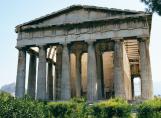2
Devine Origins and AssociationsTo the Greeks he was Hephaestos, to the Romans he was christened Vulcan. He was the deity of volcanic fire and metal work, and he was considered the patron god of all craftsmen, particularly of smiths and other metal workers.
Hephaestos (Vulcan) was the son of Zeus (Jupiter) and Hera (Juno). He was born into the pantheon of gods atop Mount Olympus. He was literally thrown off the mountain when he fell out of favour with one of his parents (there are two different versions, one in which each of his parents banishes him). His leg was injured by the fall and he was believed to be lame ever after. He is frequently depicted with a cane in classical artwork.
His fabled forge was believed to have been situated underneath Mount Aetna (a volcano) on the Island of Sicily, and it was in this place that he did his metal work for the other gods. He forged Zeus' thunderbolts and sceptre, Heracles' breastplate, Achilles' invincible armour, Agamemnon's sceptre, Athena's shield, Harmonia's necklace, and Apollo's golden chariot which was the sun. He was the craftsman behind all of the important metal articles in the myths. According to legend, Hephaestos is also credited with creating the first woman from clay, Pandora.
Hephestos (Vulcan) is almost always depicted in classical artwork bent over his anvil fashioning some new marvellous creation. He is often depicted with a beard and, as mentioned above, frequently appeared with a cane. He was reputed to be unattractive.
He was an important god representing an important craft. His skills were highly prized by the Olympian gods in the mythology, and he was honoured and worshipped by the Greek and Roman people. The Greek and Roman Civilizations saw the construction of numerous extensive temples and shrines dedicated to Hephestos (Vulcan) and annual festivals were held in the deity's honour.
The Temple of Hephaestus and Athena (pictured to the left) was constructed in 449 B.C.E. at the foot of the great Acropolis in Athens, where it still stands. The ‘Chalceia' was the name of the annual festival held in the god's honour. It was held on the 30th day of the month of Pyanopsion.
The Vocanal Shrine is the Roman counterpart. The Shrine was built in the Forum Romanum and the structure and cult played an important role in civic rituals within the city.
3
The Village BlacksmithUnder a spreading chestnut-tree
The village smithy stands;
The smith, a mighty man is he,
With large and sinewy hands;
And the muscles of his brawny arms
Are strong as iron bands.
His hair is crisp, and black, and long,
His face is like the tan;
His brow is wet with honest sweat,
He earns whate'er he can,
And looks the whole world in the face,
For he owes not any man.
Week in, week out, from morn till night,
You can hear his bellows blow;
You can hear him swing his heavy sledge,
With measured beat and slow,
Like a sexton ringing the village bell,
When the evening sun is low.
And children coming home from school
Look in at the open door;
They love to see the flaming forge,
And hear the bellows roar,
And catch the burning sparks, that fly
Like chaff from a threshing-floor.
He goes on Sunday to church,
And sits among his boys;
He hears the parson pray and preach,
He hears his daughter's voice
Singing in the village choir,
And it makes his heart rejoice.
It sounds to him like her mother's voice,
Singing in Paradise!
He needs must think of her once more
How in the grave she lies;
And with his hard, rough hand he wipes
A tear out of his eyes.
Toiling – rejoicing – sorrowing,
Onward through life he goes;
Each morning sees some task begun,
Each evening sees it close;
Something attempted, something done,
Has earned a night's repose.
Thanks, thanks to thee, my worthy friend,
For the lesson though hast taught!
Thus at the flaming forge of life
Our fortunes must be wrought;
Thus on its sounding anvil shaped
Each burning deed and thought.
H. W. Longfellow
